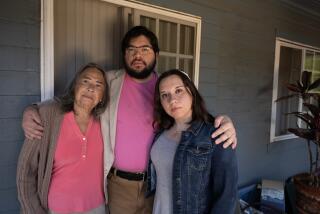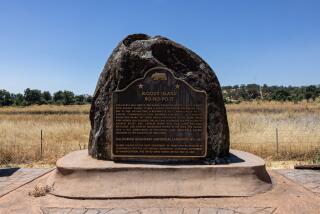Citing Stigma, L.A. May Drop Name ‘South-Central’
For years, the term “South-Central Los Angeles” has been a cultural trigger, shorthand for the city’s most intractable social ills: drugs, gang violence and poverty.
Today the City Council may try to change all that with a vote to eliminate South-Central -- the name, that is -- and replace it on all city documents and signs with “South Los Angeles.”
The move would do little to bump the term from the lexicon of television news and hip-hop music, which refer to South-Central as a gritty place of danger and desperation, alternately demonizing and glorifying it.
But Helen Johnson, a local activist who proposed the change, hopes that ridding the city of the name would help reclaim a positive identity for her Vermont Square neighborhood and scores of other communities south of the Santa Monica Freeway.
“There is a lot in a name,” said the 72-year-old retired beautician, who lives in a community of tidy Craftsman bungalows southwest of the Coliseum. “You can say a name doesn’t hurt you, but it does hurt.”
Johnson, who persuaded former Mayor Richard Riordan to launch a cleanup of city parks during his last year in office, said the term has been used to disparage a large portion of Los Angeles.
“Anytime you say ‘South-Central,’ the first thing that comes in people’s minds is this bad place,” she said. “It always has this negative sound to it, and we resent it. It gives us a bad look and a bad reputation.”
Johnson has the support of Councilwoman Jan Perry, who represents much of the area commonly known as South-Central. Perry said the term is not an accurate reflection of life in the southern part of the city.
“People there are raising their families and taking care of their property,” she said. “You can’t use broad brush strokes to define a community.”
It remains to be seen what effect, if any, the name change would have. The proposal would require the city to replace the term “South-Central Los Angeles” with “South Los Angeles” as documents and signs are updated.
Changing the name of a neighborhood to shrug off a negative stereotype is nothing new in Los Angeles. In recent years, a section of Canoga Park petitioned to be renamed West Hills and a portion of Van Nuys broke off to become Lake Balboa.
Some African American leaders said getting rid of the name South-Central wouldn’t hurt, but will not eliminate the larger problems gripping the community.
“South-Central to me is rather a designation of challenge, rather than one of calumny,” said Rev. Cecil “Chip” Murray, pastor of the First African Methodist Episcopal Church in West Adams. “I would prefer to go deeper into issues of unemployment, the conditions of schools and ways of equipping the communities to help themselves.”
While some residents may resent the term, others wear it as a badge, said Todd Boyd, professor of critical studies at USC’s film school.
“When you live someplace that’s constantly under attack, the fact you have emerged from this place is a source of pride,” Boyd said.
Some “may see this as an attempt to erase their identity, to make them disappear,” he added. “Considering these individuals are often on the margins, they could easily see this as another attempt to deny their existence, when they have tried to be visible and be heard.”
“South-Central” did not always evoke images of crime and poverty. From the 1920s to the 1940s, South Central Avenue was the heart of black culture and commerce. As race restrictions were lifted and African Americans moved west, the community name followed them across a wide swath of the city south of the Santa Monica Freeway.
In later years, drugs, gangs and especially the 1992 riots made the name South-Central synonymous with the problems confronting the urban area. The image was exported by West Coast hip-hop artists such as Ice Cube, whose song “How to Survive in South-Central” was featured on the “Boyz N the Hood” movie soundtrack. A 1992 movie produced by Oliver Stone called “South Central” dealt with gang life, and a short-lived TV series with the same name in 1994 explored the life of a single mother raising three children in the area.
South-Central “has become a shorthand for urban dysfunction,” said Frank Gilliam, a UCLA political scientist who has studied media and race.
“Once it is evoked, there is a script that ensues: people of color, poverty, gangs, pathology and dysfunction,” said Gilliam, now UCLA’s associate vice chancellor for community partnerships. “All of those things get wrapped up in the notion of South-Central.”
Johnson and others complain that the term is only applied when something goes wrong.
Councilwoman Janice Hahn, who grew up near the intersection of Florence Avenue and Crenshaw Boulevard, said she does not remember the name South-Central being used for the area until Reginald Denny and more than a dozen others were beaten at the intersection of Florence and Normandie avenues during the 1992 riots.
“Every community deserves respect, and if a name-calling gives a negative connotation, then we should do everything we can” to get rid of it, Hahn said.
When the Oscars were held at the Shrine Auditorium, reporters referred to the event as “near downtown Los Angeles” instead of in South-Central, noted community activist Karen Bass.
“I’m not sure if eliminating the use of the term will eliminate the stigma,” said Bass, executive director of the Community Coalition. “If the media paid a little more attention to covering positive things in the community, that will also help.”
For Bass and others, the problem with the term is one of accuracy. South Central Avenue runs north to south along the east side of the Harbor Freeway, a community that longtime residents frequently call “the Eastside.” (That’s not to be confused with the Eastside communities of Boyle Heights and Lincoln Heights, east of the Los Angeles River.) Referring to neighborhoods as far west as Leimert Park as South-Central does not make sense, she said, and erases individual neighborhood identities.
Activist Najee Ali grew up around Central Avenue and said he remembers his grandmother urging him to move west to a more affluent neighborhood. He now lives in the upscale community of Baldwin Hills, and has been surprised to hear news reports refer to the area as South-Central.
“You have to start somewhere,” he said of the name change. “It won’t change the quality of life, but it will give people hope and dignity in their communities, and that’s important, just psychologically.”
Johnson, the retired beautician who launched the idea, has been stewing about the issue for a good decade now. Her frustration started during the 1992 riots, when television reports referred to the rioting as occurring in South-Central, even though the disturbances happened around the city.
“It just really bugged me,” she said. “It’s just negative, plain and simple. It has the community put in a box.”
Johnson has been trying to stop the use of South-Central ever since. She taught her grandchildren not to use the term and lobbied to restore her neighborhood’s original name of Vermont Square. Last year, she wrote to Perry with a suggestion: Why not get rid of the name altogether?
When a council committee unanimously approved the proposal last week, Johnson gave a friend a high-five and beamed delightedly.
“It is so important to me where I live, because I have great-grandkids, and I don’t want them growing up with this cloud hanging over them,” she said. “A name can destroy you.”
More to Read
Sign up for Essential California
The most important California stories and recommendations in your inbox every morning.
You may occasionally receive promotional content from the Los Angeles Times.









